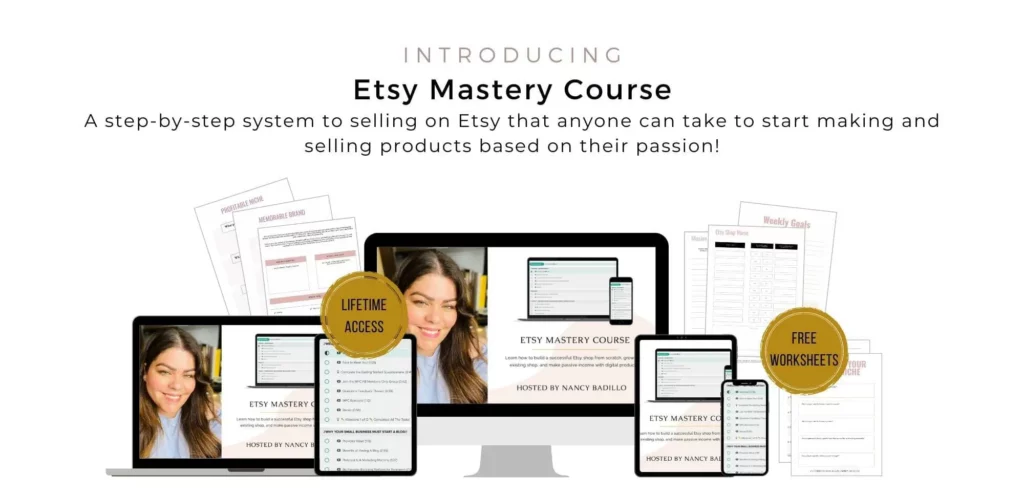Are you tired of feeling uncertain about the right way to price a handmade product? Do you find yourself constantly struggling to balance the cost of materials, labor, and your desired profit margin? Pricing handmade products can be a challenge, but it doesn’t have to be a guessing game. As a skilled assistant with a background in digital marketing, I understand the importance of pricing your products correctly – it can make or break your business.
In this article, we’ll explore the right way to price your handmade products. From understanding your target market to calculating your costs, we’ll cover everything you need to know to ensure that your pricing is both fair and profitable. So, whether you’re just starting out or looking to improve your pricing strategy, read on for expert tips and insights on how to price your handmade products the right way.

This blog post is all about the right way to price a handmade product.
Home > Etsy Biz > The Right Way To Price A Handmade Product
DISCLOSURE: This is a sponsored post. Through my links, I may receive a commission if you decide to make purchases at no cost for yourself! Check out our disclaimer for more info on how it works.
Understanding your cost when it comes to the right way to price a handmade product
Before you can price your handmade products, it’s essential to understand your costs. Your costs will depend on the type of product you’re making, as well as the materials and labor required. Start by making a list of all the materials you’ll need to make your product, including any packaging or shipping materials. Then, estimate the amount of time it will take you to make the product, including any prep work or finishing touches. Once you have a clear understanding of your costs, you can start to think about your desired profit margin.
It’s important to keep in mind that your costs will vary depending on the quantity of materials you purchase. Buying in bulk can often help you save money, so consider purchasing larger quantities of materials if you plan on making a lot of products. Additionally, if you plan on selling your handmade products online, you’ll need to factor in any fees associated with the platform you’re using, such as listing fees or transaction fees.
When it comes to labor costs, it’s important to be realistic about the amount of time it will take you to make your product. Don’t underestimate the time required, as this can lead to pricing your products too low and not making a profit. Instead, be honest with yourself about the amount of time it takes to make your product, and factor in an hourly rate for your labor.
Factors to consider when pricing handmade products
When pricing handmade products, there are several factors you’ll need to consider. First and foremost, you’ll need to consider your target market. Who is your product for, and what are they willing to pay? If your target market is price-sensitive, you may need to price your products lower to remain competitive. However, if your target market is willing to pay a premium for handmade products, you may be able to price your products higher.
Another factor to consider is the uniqueness of your product. If your product is one-of-a-kind or highly specialized, you may be able to price it higher than a more generic product. Additionally, the quality of your materials and workmanship can impact the perceived value of your product, so it’s important to use high-quality materials and pay attention to detail.
Finally, it’s important to consider your competition. Take a look at what other handmade product sellers are charging for similar products, and use this information to inform your pricing strategy. Keep in mind that you don’t want to price your products too low, as this can signal low quality or a lack of confidence in your product.

Researching the market and competitors
To accurately price your handmade products, you’ll need to do some research. Start by researching your target market and understanding what they’re willing to pay for handmade products. Look at other handmade product sellers in your niche and take note of their pricing strategies. What do they charge for similar products, and how do they differentiate themselves from the competition?
You can also use online marketplaces like Etsy or Amazon Handmade to research pricing trends and get a sense of what customers are willing to pay for handmade products. Take note of the types of products that are selling well, as well as the pricing strategies of successful sellers.
Once you have a sense of the market and your competition, you can begin to develop your pricing strategy. Keep in mind that your pricing strategy should be flexible and adaptable over time, as market conditions and customer preferences can change.
Calculating a profit margin
Once you have a clear understanding of your costs and the market, you can begin to calculate your profit margin. Your profit margin is the amount of money you make on each sale, after you’ve subtracted your costs. To calculate your profit margin, subtract your total costs from the price you plan to charge for your product.
For example, let’s say you’re making a handmade bracelet. Your total costs for materials and labor are $10, and you plan to sell the bracelet for $25. Your profit margin would be $15 ($25 – $10 = $15).
It’s important to keep in mind that your profit margin should be reasonable and sustainable over time. Don’t price your products too high, as this can lead to a lack of sales. However, don’t price your products too low, as this can signal low quality or a lack of confidence in your product.
Applying pricing strategies
There are several pricing strategies you can use when pricing your handmade products. One common strategy is cost-plus pricing, which involves adding a markup to your costs to arrive at a price. This strategy ensures that you’re covering your costs and making a profit, but it may not take into account market conditions or competition.
Another pricing strategy is value-based pricing, which involves setting a price based on the perceived value of your product. This strategy takes into account factors like uniqueness, quality, and customer demand. Value-based pricing can be effective for handmade products that are highly specialized or one-of-a-kind.
Dynamic pricing is another strategy that can be effective for handmade products. This strategy involves adjusting your prices based on market conditions, such as supply and demand. For example, if you’re selling handmade scarves in the winter, you may want to increase your prices as demand increases. Conversely, if you’re selling handmade beach towels in the winter, you may want to decrease your prices to encourage sales.
Adjusting prices over time
As market conditions and customer preferences change, it’s important to adjust your prices over time. Don’t be afraid to experiment with different pricing strategies to find what works best for your business. Keep an eye on your sales and profit margins, and adjust your prices accordingly.
Additionally, if you find that your costs are increasing over time, it may be necessary to adjust your prices to remain profitable. This can be a difficult decision, but it’s important to remember that your business needs to make a profit to be sustainable over time.
Communicating pricing to customers
Once you’ve settled on a pricing strategy, it’s important to communicate your prices clearly to customers. Make sure that your prices are visible on your website or online marketplace, and include any information about shipping or handling fees. Additionally, consider offering discounts or promotions to encourage sales.
If you’re selling your handmade products in person, be prepared to discuss your pricing strategy with customers. Be transparent about your costs and profit margins, and explain how you arrived at your prices. This can help build trust with customers and encourage repeat business.
Common pricing mistakes to avoid
When pricing handmade products, there are several common mistakes to avoid. One mistake is pricing products too low, which can signal low quality or a lack of confidence in your product. Another mistake is pricing products too high, which can lead to a lack of sales.
It’s also important to avoid changing your prices too frequently, as this can confuse customers and damage your reputation. Finally, don’t forget to factor in any fees associated with the platform you’re using to sell your products, such as listing fees or transaction fees.
Conclusion and next steps for the right way to price a handmade product
Pricing handmade products can be a challenge, but with the right strategy and approach, it can be a profitable and sustainable business. Start by understanding your costs, researching the market and competition, and calculating your profit margin. From there, develop a pricing strategy that takes into account factors like your target market and the uniqueness of your product. Be prepared to adjust your prices over time, and communicate your prices clearly to customers. By avoiding common pricing mistakes and staying flexible, you can build a successful business selling handmade products.

+ show Comments
- Hide Comments
add a comment